The most generally believed myth prevailing today is that the Earth is a colonial outpost of an extraterrestrial civilisation. In recent prehistoric times, this civilization exercised its super-sophisticated technology by quarrying inconveniently massive stones, transporting them for inconvenient distances over some of the world's most inconvenient terrain, and then piling them into temples on the scale of mountains - their way of getting their rocks off, so to speak. Whether or not you accept the scenario sold by Erich Von Daniken, scientists and engineers agree that the Great Pyramids of Egypt and other prehistoric megalithic monuments around the world are constructed on such a colossal magnitude that there's no way ordinary human beings could have done it. Even today, the monuments at Abu Simbel had to be cut into pieces to move them a few hundred yards from the Nile waters rising behind the Aswim Dam because our heaviest machinery was not otherwise able to manage the task. A number of authors, professional archaeologists, and more or less talented amateurs have published calculations proving that the magnitude of the pyramids exceeds all the human resources known to be available for construction at the time.
When I address myself to the construction methods of the pyramid builders, I am forced to turn in my amateur card, since I worked for several years in heavy earth construction. My last employer handled the largest contracts undertaken in this part of the country at the time, and I was being trained to supervise construction of an industrial town site. Whenever I read a story about how the prehistoric megalithic monuments may have been erected, even though I cannot make an on-site job survey, I check all the measurements to see that they agree. Every carpenter who is given plans for three twelve foot rooms on a thirty-six-foot foundation knows it can't be done. Architects frequently forget to allow for the thickness of the walls because they never have to do the job and because the contractor pays for errors.
If you take the trouble to calculate the volume of a megalith from the dimension given by various writers, and multiply it by the average weight of stone (with a specific density three times water), you will find the most impressive magnitude of the prehistoric building industry is error in simple arithmetic. Even if we assume that the length and width of the megaliths are not multiplied by literary hype, they are reduced to human proportions by correct calculation. Although Stonehenge could have been built the way the British scientists staged it for television, it wouldn't have been. The operations are regarded as too dangerous by today's unionized workmen. The prehistoric laborers' workmens' compensation would never have approved the contract. Estimating the job as if my employer had been asked to bid on Stonehenge, I found that standard techniques known throughout the trade proved simple and economical. It is inconceivable for the prehistoric engineers to have done it in any other way. Megalithic construction was the usual method of building public works the world over. In the Stone age it had to be the most economical technique available, just as steel frame and reinforced concrete is today; and the methods had to be simple enough for gormless apprentices to follow with no more than the usual number of goofs. If scientists had asked tradesmen how megalithic monuments could be built, there never would have been any mystery.
The standard way to erect pylons would have made no scene for Charlton Heston in The Ten Commandments. The pylon is drawn to the site on a stoneboat; pallets have been traditional in the moving trades since prehistoric times. A thousand slaves driven by whips are not necessary, because a thirty foot pylon with an average cross section of five square feet weighs less than fifteen tons. Three hundred slaves, or a dozen oxen, could handle it easily. Even if the ancients had unlimited slaves, they used beasts of burden because animals are more efficient; the primitive Eskimo knows enough to hitch a team of dogs to a sled.
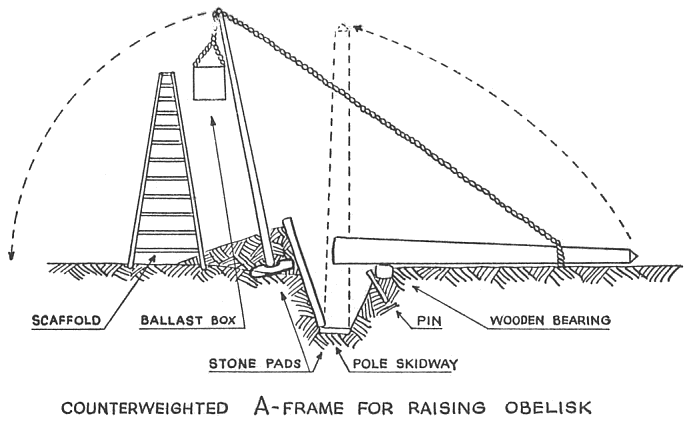
In the socket prepared to receive the pylon, the bottom is laid with a slab of stone for a footing to prevent the pylon's shifting and toppling over in the course of time. The edges of the socket, where the base of the pylon overhangs, is buttressed with logs to resist the pressure of the stone when raised against it.
On the other side of the socket from the pylon, a pole A-frame is raised. A line is fastened to the top of the pylon, passed over the apex of the A-frame, and attached to an empty bucket suspended well above the ground. A scaffold is erected to the bucket so that a chain gang can pass ballast and fill it. When the weight of the ballast in the bucket is sufficient, the A-frame rotates on its legs as the bucket is lowered to the ground, drawing the pylon's base over the socket to the abutment, then raising the top of the pylon as the shaft rotates on the edge of the socket. When the pylon is practically erect, it plops into the socket. Voil�! No sweat. This is the probable method used to erect the posts for the massive triliths at Stonehenge.
Exceedingly massive lintels, such as found in the Andean ruins and at Stonehenge, were probably raised to the tops of the posts by a modification of the technique used to erect the posts. First the crew had to buttress the uprights with timbers and earthen fill. Barely a tenth of the posts at Stonehenge are held in their sockets; with so little lateral support on a foundation of broken and compressed rock, the horizontal movement of a lintel being moved over the tops of the posts would have pushed them over this is a hardhat job. Gerald Hawkins, the decoder of Stonehenge, protests that the labor needed to provide all the posts with buttressing would have exceeded the effort of raising the lintels, but my platoon would be on unemployment insurance the day after they were hired if they didn't have a pair of posts buried for the arrival of the lintel in the morning.
To begin with, experienced workmen look for fill that's easy to shovel. Then they use the same fill for each arch in succession, merely having to fling it over. When the lintel is brought to the base of the buttress on its boat, an H-frame is raised on stone pads on the other side of the arch. Lines are fastened to the stoneboat and thrown over the legs of the H-frame The weight of a ballast box suspended by the lines is what keeps the H-frame upright. A chain gang mounts a scaffold to fill the ballast box with stones. If the distance over which the box will fall is measured carefully to equal the distance the lintel must rise, the H-frame will slowly rotate on its bottom legs, drawing the lintel up the ramp on the buttress until it comes to a gentle stop right above the pins receiving it.
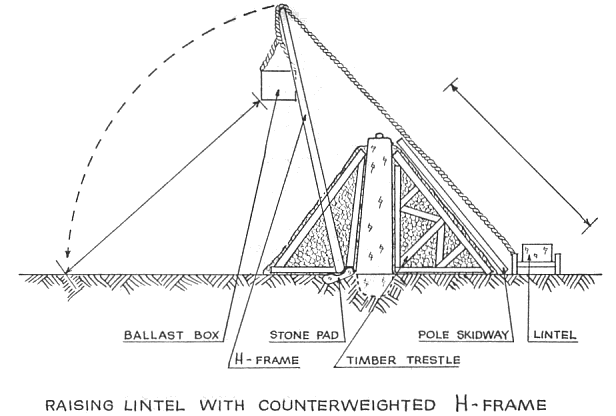
To skilled laborers who do this kind of work for a living, the only question is why the architects chose a quarry on the other side of the Bristol Channel. The construction specifications of Stonehenge call for about 100 five-ton monoliths to be hauled twenty-five miles overland with a few hundred feet of rise. A five-ton load is no big drag for a couple yoke of oxen. The present structure at Stonehenge is the third of its kind built at the same site. The earlier stones were smaller and probably more numerous. By the time a few dozen sledges had been dragged over the trail from the quarry, the grade would have been cleared, soft spots filled with rocks, and slopes cut down to a comfortable angle. You need only see a path worn between farmhouse and outhouse to appreciate how quickly a repeated trail becomes a thoroughfare. To turn the grade into a proper railway, all that is needed is wooden poles laid along the right-of-way for the sledges to slide on. With some lubrication, properly cut skids will slide the stoneboats with less friction than the old Red River carts.

The smoothing of wooden rails for a skidway may seem more laborious than the dressing of the megaliths, but wood is ever so much easier to work. After one monument was completed, the roughly squared durable oak rails would be taken up and laid down for another construction elsewhere; the investment in transport machinery was thus amortized over many jobs. When the rails became crushed to the point where they could no longer bear the weight of sledges, the best sections (like worn-out railway ties) would be gleaned by poor folk for domestic structures, while the broken sections would be used for fuel.
Another shipment of about a hundred more blue stones had to be brought in from a quarry a few miles closer. To move these final megaliths, weighing from thirty to fifty tons, even twenty-mule teams would have sweated. To make the beasts sweat more heavily, between the quarry and the job site there is a low ridge to surmount. Archaeologists have sought the easiest grade over the ridge as the way the ancient Britons brought the megaliths to Stonehenge, which is why archaeologists cannot figure out how the monument was built. When there is a lot of altitude to gain in a short distance, however, experienced movers do not seek the easiest grade; they survey the range until they find the steepest cliff. Then they build a funicular railway, operated by counterweights, to raise the load as quickly as possible. (Travelers say that funicular transports on cliffsides are still used in England today.) Between the quarry and the job site there is a net loss of altitude, and once the cargo is raised to the summit of the dividing ridge, even fifty tons is no big sweat for teams of oxen to drag downhill.
Constructing the Great Pyramids was not a problem of engineering technique, but of logistics. The scale of the monuments is so awesome that it is pure fantasy to estimate on the contract without knowing the resources available.
Logistics aside, the pyramidal design expedites its own construction. To begin with, the pyramid is its own ramp. To raise the building blocks to the working level, all that needs to be done is to lay a pole skidway against the sides. A line is fastened to the stoneboat at the base of the pyramid and passed over a pulley wheel at the top level. The line is then strung right across the top level, passed over another pulley wheel on the opposite side, and fastened to another stoneboat carrying an empty ballast box. This stoneboat is held by the line on another pole skidway laid against that side of the pyramid.
Second, the stepped slope of the pyramid also serves as its own scaffolding. A chain gang standing on the steps passes small stones from the bottom of the pyramid to the ballast box on the top of the slope. When the box is filled, it slides down the skidway, dragging the building block up the other side. When the traverse is completed, both stoneboats are emptied, each load is replaced with its opposite number, and the transport is repeated in the opposite direction.
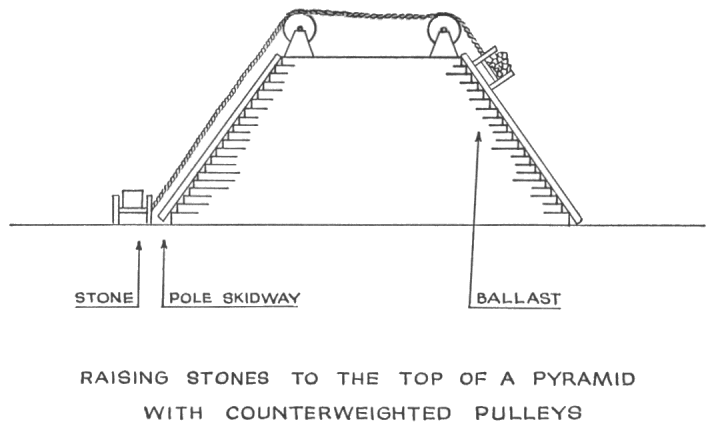
The Great Pyramid had sides four hundred feet long, so a dozen counterweighted shuttles would be in operation continuously, bringing blocks to the masons faster than they could be laid. As the pyramid rises, the area of working level diminishes; but at the same time, the number of blocks needed to lay each course is reduced by a factor of the square of the shortening of the sides, so the construction rises faster as it goes.
Dragging the pyramid blocks to working level up earthen ramps is one of several well publicized techniques worked out by scientists, including some professional engineers. Earthen ramps are plausible because they are feasible. But this pedestrian kind of engineering is never used by workmen in a competitive industry. An earthen ramp, besides requiring the moving of several times the amount of material involved in the pyramids themselves, won't stay put under long and heavy use. Earth flows under pressure, and the weight of the ramps themselves would be sufficient to generate flow. The earthen slopes of railway grades are built on a trestle framework filled with rock to keep them stabilized. It is impossible to walk on fresh earthen fill, nor will fresh fill support several tons of rock and the slaves to haul it. A hard surface must be laid on the ramps to keep feet and load from sinking into it and tearing the ramp down about as fast as it can be rebuilt.
These problems are not insurmountable; all it takes is a lot more work. It is the cost-time-labor inefficiencies that make naive technology impractical. You must remember that pyramid building in ancient Egypt was a big industry, developed over thousands of years, and Egyptian businessmen practically invented accounting.
Critics object that there is no record of the Egyptians using wheels for industrial technology at the time the pyramids are believed to have been built. This is a specious argument when examined in historical context. The only reason we do not know how the pyramids were built is that there is no record to tell us. Without those missing records, we cannot know whether the Egyptians used wheels or not. We do not even know for certain that the people we call the Egyptians built the Great Pyramid in the first place. The only convincing evidence of the time of its construction is a cartouche painted on one of the interior stones signifying that the quarry supplied the order for Cheops.
When there is but one piece of evidence, we have to make of it what we can; we cannot deny its significance. But people in the construction business know that when a shipment of three million units is spot-labeled with the customer's order number, marking just one unit is not the practice; in a normal shipment of that amount, at least three thousand stones should be labeled. And why would a shipping label be left on the interior facing of a religious monument? The possibility should not he overlooked that the single scription of Cheops's cartouche may be an example of prehistoric graffiti. Until authenticated records are provided, it is not unreasonable to assume that engineers who developed mathematics at least as far as the Greeks, who designed a monument incorporating the ratios of Earth, Sun, and Moon, who perfected astronomy to the limit of the unaided eye, and who put a polished finish on a stone mountain with such precision that irregularities are practically undetectable without measurement by laser, probably also used the wheel.
Rather more puzzling is the absence of any record of the ancillary industries needed to support pyramid building. The manufacture of tool bits to cut stone must have employed as much manpower as the transport industry involved in moving monoliths by the ton. Construction men know that the replacement of lost tools is a serious expense for the company and crew. Yet not only is there no record of the means the prehistoric stonecutters used, but no tools have been found in the rubble left behind after construction. Neatness must have been rewarded beyond all other virtues in the ancient Egyptian construction industry; you need only consider the polished casing of the Pyramids to believe it.
Reporters compare the precise setting of the prehistoric megaliths with the casual tolerances of modern stonework and marvel. The only reason modern builders work to a tolerance of a quarter-inch is that there are no practical reasons to be more precise - and powerful economic reasons for not trying to be. (But if you ever visit a dry dock, you will see tonnages thousands of times more massive than the most stupendous work of the ancients set into position with a precision comparable to the Great Pyramid's; if a ship does not balance on its keel exactly where the blocks are set for it, it may topple over and put the dock out of business for several months until it is cut to pieces for removal like the monuments at Abu Simbel. Out of necessity, shipwrights developed techniques for placing hulls by hand because no machmery is big enough.) Given economic reason to be exacting, modern masons can equal the ancients. (The grinding of giant astronomical mirror lenses is a hand job). In a tradesman s opinion, the only reason the prehistoric megaliths were dressed to tolerances within a millimeter (at least once in a while) is that the labor was economical to perform within the context of the masons' operation.
A megalith brought into position on the course of stone being laid is supported on two leather bags filled with sand, one bag at each end. A platform of viscous clay or mortar is built up between the sandbags. When the bags are opened, the sand pours out, allowing the stone to settle onto the clay platform. As soon as the bags are free of the weight of the stone. they are snatched away by apprentices (the slow boys can be recognized kneading mortar with the stumps of their arms). If the top surface of the clay is slanted, the megalith will slide by its own weight, tight against its neighbor. The only technical problem is mixing clay to support the stone long enough for maneuvering, but still fluid enough to he squeezed out completely by the time the next stone is brought in for laying.
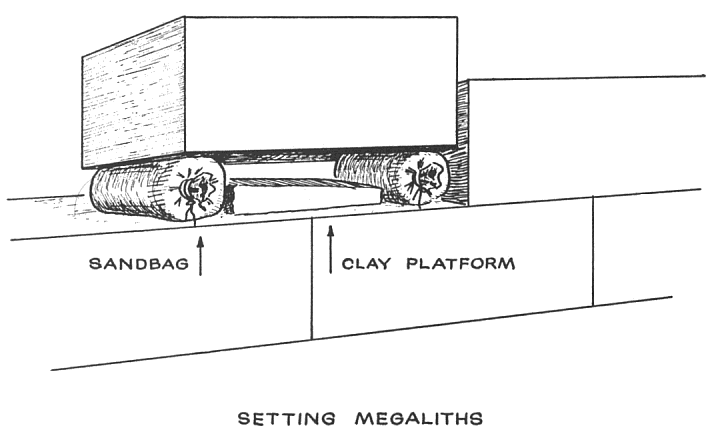
For a megalith weighing dozens of tons to slide easily over the clay, the broad bearing surfaces must be smoothly dressed. As the smoothing of the broad surfaces cannot be left undone, it is no big deal to dress the abutting ends to an equal finish; the precision of the ends is not critical, so the job can be given to apprentices for their practice. A technique like this would be considered only when the cranes raising the stones to the working course were not adequate for precision setting.
It is likely that the millions of blocks used in the construction of pyramids were transported from the quarry to the job site over a rail skidway. Rails are far more efficient than log rollers. But once you see construction crews at work, other possibilities came to mind. We know that megaliths were transported by barge over water. Now, one technical problem the ancient merchant marine had to solve was getting heavy crates onto a boat. In those days, you see, boats were comparatively small, and when a massive cargo was carried across the gunwales, the boat turned turtle. So the traditional merchantman's crane was developed, using counterweights to maintain an even keel while loading. In the two hundred years since power winches became universal, it has been forgotten that today's basic machinery was developed when all the power had to be supplied by muscle. Winches in the confined area of a top deck are limited to small loads, and pulleys are limited by friction, unless fitted with roller bearings and chain. So when the ancient longshoremen had a heavy idol to ship to Thebes, they used counterweights to lift the thing as well as get it over the gunwale without capsizing the boat. Herodotus says that the Egyptians were exceedingly clever in the invention of counterweights.
Once the system of counterweights is developed, construction practice inevitably turns to megaliths, because it is far easier to handle one big stone than to shape the hundreds of little blocks each megalith replaces. By far the biggest advantage of megalithic construction is permanence. Brick buildings can be torn down by every marauding horde that passes through the country, but no one is going to knock over a temple held together by fifty-ton lintels.
The counterweighted cranes developed to pass cargo between ship and shore need not be limited to a single lift. In crowded shipyards today, sections of ships are transported across busy work areas through the air, being passed from one crane to another. Workmen become so skillful that the loads may never be set down between first lift and final deposit. The same principle is practicable for the transport of building stone from the prehistoric quarry to the job site. When heavy cargo is shipped out by the millions of units over hundreds of years, economics justifies the construction of a chain of cranes, set about fifty yards apart, to transport material in a continuous stream over all kinds of terrain - like a pipeline, the most efficient of all material transports.
The design of the merchant ship's crane is scaled up for overland transport of ancient building materials. The base of the transport crane is a stone disc, about six to eight feet in diameter and a foot or two thick. The bottom surface is flat enabling it to rest securely on the ground; the top surface is fashioned into a shallow cone. Another stone disc of the same dimensions is set onto the base. The bottom surface of the top disc is made into a negative cone so that the wheel can rotate, balanced on the base without sliding off.
At opposite sides of the top surface of the upper wheel, hemispherical depressions are carved, about a foot deep and wide enough to contain the fire-hardened butts of a pair of booms. The booms can be extended by splints to extend over one hundred feet upward and outward at a forty-five degree angle. They are held balanced in position by a line passed over their upper ends, from which a heavy container is suspended at each end. Now, if a light line is suspended from the center of the main cross line, a small amount of force will pull the line down; closing the straight angle of the cross line brings the ends of the booms together. As the booms come together, rolling without friction in the cups holding their butts, the top ends rise, lifting the containers. The practical amount of rise is no more than a foot or two before the changing load vectors multiply the tension of the lines to their breaking point. But within this narrow range of efficiency, one man can raise many tons, and the requirements of transport can be served as soon as the load is clear of the ground.
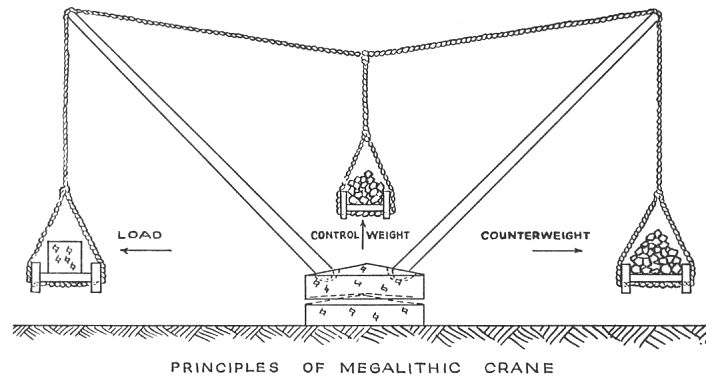
In operation, cargo is loaded onto one container, while the other container is counterbalanced with ballast. When the cargo is a replicated building block, the weight remain constant, so there is no delay in balancing it with a counterweight of known measure. The control line suspended from the cross line carries a counterweight, too, sufficient to balance the container units, so the operator riding the top bearing stone need pull down on the control line with little more than the force required to overcome inertia. The control line also serves to take up slack in the cross line as the hawsers stretch during service. Once off the ground, the load is carried around the reach of the booms by rotating the crane. The friction on the bearing stones is overcome by employing a draft animal.
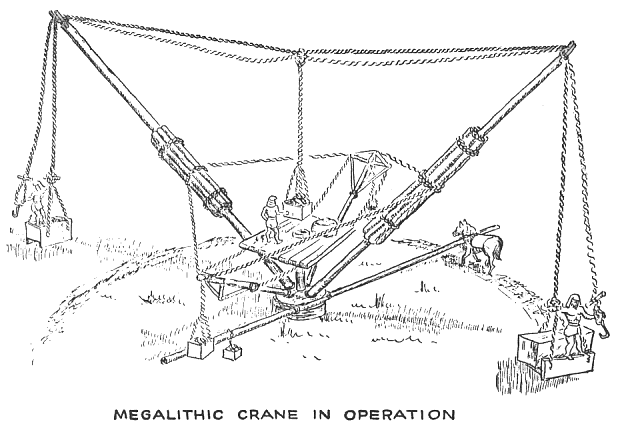
A chain of these transport cranes would pass a continuous stream of building stone from the quarry to the city at walking speed, pausing only long enough to transfer the loads from one crane to another; while down the other side, an equal weight of ballast would be transported from city to quarry. The ballast side need not be deadheading all the time; instead of ballast, supplies needed by the quarry can be packed for transport in containers of unit weight. This system is low technology, labor intensive and non-polluting; when all the costs are accounted for, we can hardly improve on the efficiency today.
Once industrial machinery is put into production, the men who do the job always add improvements with or without the cooperation of the design office. Sooner or later, it will occur to a crane jockey that his pony is sweating too hard, so he will drill the center out of the top bearing to form a pipe through which he can pour clay slip to lubricate the bearing. The weight of the load will hold the bearing surfaces so tightly together, and they will be ground to such an even curve, that very little - if any - of the slip will be able to flow between them. So the operator will add a pole to the bottom of the counterweight of the control line; the butt of the pole fits nicely into the lubricating hole. When the weight is pulled down, the tamp is forced onto the clay in the pipe, and waddayaknow - pressure lubrication! An alternate means of lubrication probably used, instead of the fanciful design just described, is the inclusion of naturally oily shoes between the bearing surfaces, like the lignum vitae used today in the heaviest marine bearings.
A stationary crane has limited use, even in an industrial yard. When the ancient engineers designed the transport crane, they made it portable. When the job is completed, components are disassembled. The tamp for the pressure lubrication is passed through holes drilled through the centers of both bearing stones so that they will roll like a pair of wheels joined by an axle. The booms and spars are balanced across the axle. The whole bundle of sticks is tied together by the lines. and the draft animal is hitched up to haul the crane away to the next building site.
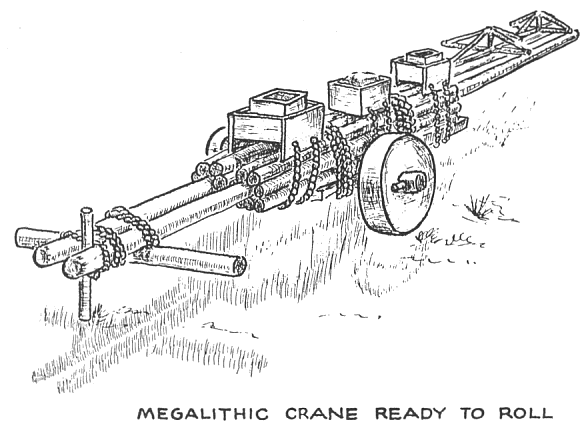
The first critic to whom I submitted this engineering system was a retired Master of Exams from Cambridge University, J. Lloyd Brereton, to whom I am indebted for first publication. Brereton reasoned that transport cranes must have been as ubiquitous in the Age of Gold as trailer rigs are on today's highways, so he referred to the Encyclopaedia Britannica to see if any available evidence supports such speculation. Obviously, wood and rope do not outlast the pyramids, so we cannot expect to find any organic remains of the prehistoric transport system. But throughout the sands of the Middle East, archaeologists have found huge stone discs in considerable numbers. Tribespeople who found them first have been using these `millstones of the gods' for thousands of years to grind their grain. The hole in the center of the upper disc is desigmed to pour in grist, and the conical bearing surfaces allow the flour to flow out around the edge as the stone is turned by a draft animal.
Naturally, modern scientists assume without question that the stones were manufactured for no other purpose. But it is curious that no other societies in the world have developed rotary millstones like the `millstones of the gods'; everywhere else, grain is ground by women rubbing it back and forth in cylindrical bowls in mortar-and-pestle fashion.
The real mystery of the megalithic monuments is that no one over the past two thousand years was able to figure out a way to build them. Yet any competent tradesman could have told the authorities how to build these megalithic monuments, if anyone bothered to ask him. But no one did ask, because most people believe their authorities know everything. In Rhodesia there is a magnificent city built of precision masonry, constructed on a monumental scale comparable to the minor pvramids; the natives call the ruins Zimbabwe, and they attribute the construction to their ancestors. The European invaders found it necessary to establish the myth of white supremacy in order to justify their rape of the country. If the black people are capable of constructing cities like Zimbabwe, then the whites cannot possibly be biologically superior. So scientific authorities assured the world that Zimbabwe was constructed by a mysterious civilization, most likely the same people who built the pyramids; but whoever they were, they were not black. Now that Rhodesia has been taken over by democratic parties, the country is being called Zimbabwe by its own people, and the world is accepting as fact that the natives' ancestors are the people who built the monumental city.
This essay is not intended to explain how the prehistoric megalithic engineers did build their monumental temples. That question can he answered only by archaeologists on the basis of the evidence they dig up. The problem is, how could it be possible for a Neolithic society to have engineered the monuments we find today?
Now just because the engineering outlined in this essay is derived through the oldest traditions of the construction trade, and proven practical for megalithic monuments, it does not mean that the ancients used these methods or anything like them. Construction contracting is the most creative enterprise. At any given time and place, a contractor avails himself - from a variable selection of resources within his competence - to implement the technology he believes most likely to be executed profitably. A big-time operator like General Pyramids Consolidated, needing to keep its army of slaves busy earning its garlic during a slack century, may very well have put them to work piling earthen ramps up the sides of the pyramids with wicker baskets. On the other hand, I believe the way the ancients transported megaliths for their monuments was to attach a small tuning fork to each stone, causing the module to levitate when the properly tuned vibration was sounded. When a monolith is set to resounding, its vibrations keep it in the air most of the time. During the greater part of the wave cycle, when the mass is floating, a light touch will move it in any direction.
I believe ancient engineers used this technology because the ancient myths describe it. This application of musical theory is far too sophisticated for a Stone Age people to incorporate in their myths unless the authors actually witnessed the technology in operation.
You didn't think I was going to let you go without some speculation, did you?